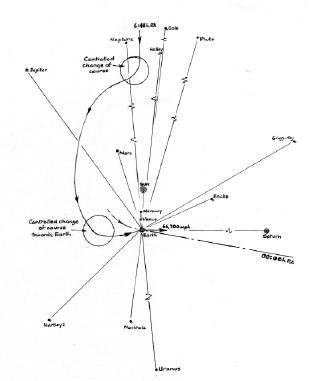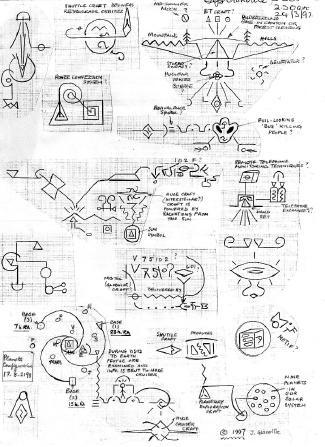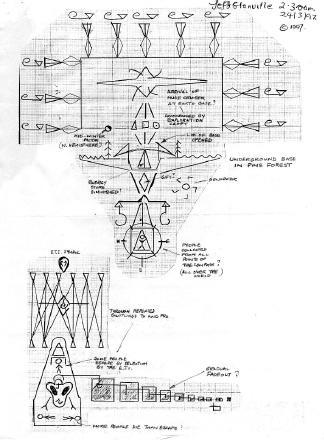UFOs in Reality (35 page)
Authors: T.R. Dutton

That was the unsatisfactory end of the exercise until I was in the final stages of creating this book.
The Tunguska Analysis
As recorded by Chapter 18, during November, 2006, I had received authoritative information (from Edward Ashpole) giving me the actual location of the Tunguska event and an accurate local time for the explosion. This gave me the opportunity to run my AT programs. Fig. 44
presented the resulting timings graph and the very impressive result obtained.
But there was still more to be discovered when I turned back to re-examine Jeff Glanville’s Scrabble diagram.
During June 2007, whilst incorporating amendments to this book, I found myself again studying Jeff Glanville’s Scrabble diagram. It occurred to me that the previous analysis of it, perhaps, had not been sufficiently thorough? So, once again, I ran the astronomical software to display the sky as it would have appeared during June 30th, 1908.
It dawned on me that much depended upon whether Jeff’s diagram was showing the solar system viewed from the Northern Celestial Hemisphere or the Southern one. With Pluto and Jupiter in the same positions relative to Mars, the view had to be one viewed from the Southern Hemisphere of the sky. However, the positions of other solar system bodies did not conform at all well. The view from the Northern Hemisphere, looking down on the solar system, was much better, but this meant that the positions allocated by Jeff to Pluto and Jupiter had to be reversed and the actual position of Saturn was close to the counter marked Uranus by Jeff. (In the view from the Southern Hemisphere, nothing had filled that space).
After looking at all the aspects, it seemed that the view from the Northern Celestial Hemisphere, after swapping the Glanville positions of Pluto and Jupiter, could be regarded as a reasonable representation of the actual sky on the date of the Tunguska explosion. Fig. 53
is the revised diagram, to which other annotations have been added. The position of the Sun provided the datum for this and some meaningful observations could then be made.

Fig. 53
The object is shown entering the solar system travelling towards the Sun, from the direction of Neptune. Its location in the sky would have been 6:48 h. RA. This is close to the intersection of the Galactic (Milky Way) Plane with the celestial equatorial plane. A controlled turn is then depicted, probably following the Galactic Plane, with the object now heading into the southern hemisphere of the sky to skirt round the group of planets cluttering the direct route to Earth. Whether or not the object moved in the galactic plane or entered the solar system’s ecliptic plane, this controlled manoeuvre immediately tells us that the depicted path would have had to have been followed by an
artificial craft
, not a comet or an asteroid. At another point in its path facilitating this, a second controlled manoeuvre is depicted, which would enable the object to intercept the Earth at the required angle, approaching from the south. As the annotations show, the Earth would have been moving away from it at an average speed of approximately 66,700 miles per hour as the planet moved round the Sun. This means that the approaching craft would have required more than that speed to catch up with the planet (with allowance for its approach angle), plus an increment to enable it to perform its surveillance mission. Its approach speed would therefore have been in the region of 100,000 miles per hour. Measuring from the diagram, the object’s approach to Earth would have been from the direction of 14:14h. RA. This path happened to be roughly aligned with the computed Track No.2 and with Comet Encke, located at 2:19 hr RA., which is in accordance with my AT observation that solar system bodies seem to be often used as navigational markers. If we now apply the other rules of the Astronautical Theory, on its northwards approach to the Earth’s equator the craft would have adjusted its speed to follow the predetermined path over the Earth’s surface. This would have been chosen to overfly the area targeted for the mission. Given this scenario, the track chosen could very well have been the path indicated by Figs. 44, 45 and 46 and, as suggested previously, it would then seem that control was lost in the later stages of its mission, causing it to descend uncontrollably into the denser layers of the atmosphere with reducing meteoric speed and, finally, to create an enormous (nuclear?) explosion. The integration of the amended Glanville diagram with the AT’s result is something quite remarkable.
Other dining table happenings
Many other strange things have since happened on that dining room table. Items have appeared from unknown sources and then disappeared again after lying a day or so on the table. David Glanville sent me a video recording showing some of the strange events. One such happening involved the appearance of a small telescope on a stand, together with drinking glasses in clusters. No one knew who the telescope belonged to but, presumably, it was returned to the owner after, subsequently, it disappeared from the Glanville’s table. Another, startling, episode involved the appearance (not for the first time) of a large and ornate pottery chalice that was producing a flood of liquid as the camcorder recorded it. This liquid was bubbling from the chalice and creating rivulets on the highly polished table. It was then running off onto the carpet. How the liquid was being supplied to this vessel in such a large quantity was a complete mystery, but Jeff decided to get a sample on the end of his finger and then, rashly, to taste it. It was horribly salty.
More recently, whilst in conversation with Thelma Glanville on the telephone, I wondered if she would ask a question for me in Scrabble pieces on that table. She very kindly agreed to co-operate. This was the question I asked
:
“Why do you use comets?”. The reason for that tongue-in-cheek question was to check out my observations that, during SAC/UFO activity periods, comets had been frequently found to be in alignment with the approach/departure paths determined by the AT programs. It was a leading question that I expected to be ignored, denied, or generally glossed over. A few days later Thelma had an answer for me. It was this: “Less energy required”. That was an incredibly sensible answer, which seemed also to confirm my observations. In addition, it seemed to confirm that, indeed, we were dealing with space-travelling ETs.
Sinister drawings from Jeff
The next information I received during 1997 came to me as two more sheets of diagrams from Jeff, dated March 24th and with the time given as 2:30 am. On that occasion, he had experienced them after coming round from sleep in the early hours and had just wanted to go back to sleep again, but the images persisted in his vision, and prevented that. So, he’d grabbed a cardboard box from the top of his wardrobe and spent some considerable time drawing all he could see. The amount of detail in some of those drawings was impressive. The diagrams on those two sheets were more elaborate than previous ones and seemed to me to present a rather sinister scenario. They are shown by Figs.54 & 55.

Fig. 54
One of the more mundane representations was a diagram in the bottom left-hand corner of Fig.54. This seemed to be another representation of the solar system. In this plan view, the planets could be recognised by their relative distances from the central sun and three equally-spaced spiralled arms (anticlockwise) connected the central sun to three symbols placed on the outer fringes. The symbols were a circle, a triangle and a square. Could they have represented bases in space? I wondered. Analysing that diagram using astronomical software, I discovered that it might represent the situation on August 17th, 2198, about 200 years from the, then, current time. That would be the right kind of orbit period for objects orbiting the sun at the implied distances from it. In other words, those symbols might have represented the location of symbolic ‘bases’ in 1998. If so, two of them were located in the sky at the two of the AT’s fixed star-related approach and departure path orientations. How very interesting!
But the diagram in the top right-hand corner was even more interesting. It seemed to depict a cross-sectional view of an underground base, sited in pine woods, with mountains to the left and hills to the right. The big hole in the ground contained a large pyramid shape and the hole was covered by a huge shallow dome. Above the dome were a circle, a triangle and a square with converging radial lines linking them to the dome. Underground there appeared to be something depicting a generator of some kind and, possibly, a nuclear power source. A sinister smaller diagram below this seemed to depict an evil-looking insect-like ‘face’ linked, on either side, to prostrated (dead?) stick people.
The second sheet (Fig.55) was an even more elaborate depiction of the
opening
of the underground ‘base’.
In this very elaborate diagram the lid of the base was shown opened, the pyramid shape was shown to be half its original size, that diamond-shaped ‘gift’ (from the earlier globe diagram) was below it, contained within converging lines. Above the opened dome, the triangle, square and circle were linked by radial lines to the central region of the opened dome and further, upward-projecting, radial lines from them converged beneath a huge shape, which was similar to a galaxy when viewed edge-on. This shape was constructed entirely with straight lines, but from the central hump (or diamond) were generated four equally-spaced curved lines. The object looked like the depiction of a huge craft. Overall, it seemed to be in communication with the geometric objects and through them, with the underground base. To the left of the diagram, in the sky above a pine tree, a Last Quarter moon was drawn, the angle of its terminator suggesting that it was probably a winter moon in the northern hemisphere. The huge ‘craft’ was placed at the centre of a three-sided rectangular frame or arch. That frame was surrounded by eleven spiralled ‘power’ symbols, which were linked to the frame by arrow-like symbols, each made up from a triangle attached to an elongated diamond.

Fig. 55
Below that diamond, shown
beneath
the underground base, was suspended a simple balance (set of scales), with a triangle linked to a dangling power symbol at each end of the balance arm. Diverging radial lines from the centre of the ‘balance’ connected to a circle, the periphery of which was divided up into eight equal segments, giving the appearance of a magnetic compass. In a rectangle within this circle, a single standing stick person was shown encapsulated within a triangle. At the bottom of the same page, that insect-like face featured again, with lines on either side of it linking to prostrated (dead?) stick people. To the right of the insect head was a linked succession of shaded-in squares. These rapidly diminished in size as they progressed away from the insect face. Above this face an upright stick person was shown being apparently uplifted by a triangle. Immediately above this was a diagram giving a rough depiction of the large ‘craft’ at its centre, in the midst of a set of criss-crossing lines linking triangular shapes above and below it. Overlooking it all was a rough depiction of a typical alien face (an inverted pear-shape).